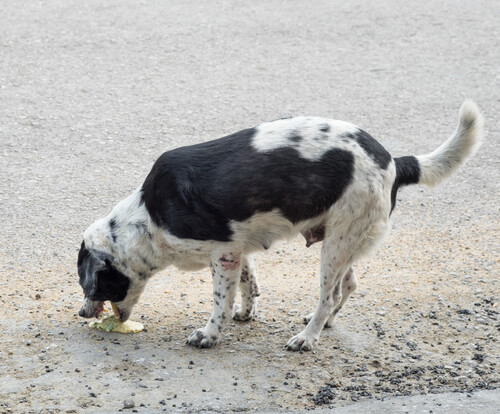Poisoned Bait: What Precautions Should You Take?


Written and verified by the lawyer Francisco María García
There are still many cities where it’s common to use poisoned bait and other similar things to get rid of pests. In these cities, you should be on high alert when taking your dog out for a walk, especially if you walk him without a leash.
In this article, you can read some tips to prevent your dog from getting poisoned by pesticides and learn what to do in case he does.
The danger of poisoned bait for dogs
Poisoned bait is a method that has been used for quite a long time, especially when it comes to mice and rats. It generally involves using small pieces of food with poisonous substances in them.
Most of these chemicals are blood thinners. So, when the rat eats the bait, the poison quickly spreads through its body and causes it to bleed internally and die afterward.
If your dog eats a piece of this bait, the same thing will probably happen to him. That’s why you absolutely have to act fast and prevent the chemicals from spreading throughout his body.

What should you do if your dog has eaten poisoned bait?
If this happens, the best thing to do is to take your dog straight to the vet. However, if you live far from a clinic, you need to know what steps to take in order to help treat the poison. Poison also spreads very quickly, so you have to act fast.
Forcing your dog to vomit to get rid of the poison
The first thing that comes to most people’s head in these cases is to force their dog to vomit. This method is only safe if you know how long ago your dog ate the bait. The honest truth is that vomiting only works if your pet has ingested the poison within the hour. That means the poison hasn’t had time to make it through the body yet.
If it’s been longer, forcing your dog to vomit can be even more damaging to his health. Once the poison has spread, its vomit will become extra acidic and cause major damage to its digestive tract. If it’s been more than an hour, take your dog to the closest clinic. The food has already been processed and vomiting won’t work.

How to force your dog to vomit
In order to make your dog vomit safely, you’ll need a needle-less syringe and hydrogen peroxide, which are two things that should always be in your emergency kit. First, fill up the syringe with the hydrogen peroxide. Then, open your dog’s mouth and shoot the liquid in all at once.
It’s also good to keep your dog’s mouth closed for a few seconds afterward to make sure he swallows all the liquid properly. He will have to vomit within a few minutes.
Tips on what to do in an emergency situation
- Remain calm. This is probably obvious, but nervousness is the number one enemy of successfully managing an emergency situation. If your dog has eaten a toxic substance of any kind, you have to act confidently and quickly. Your composure could save his life.
- Go to the vet. First aid is an important part of stopping your dog’s body from digesting the poison, but it can’t replace the vet. After you’ve done the basic steps of first aid, go straight to a veterinarian clinic.
How do you keep your dog from eating poisoned bait?
The best way to prevent this is to pay close attention to your pet while you’re walking him. If you suspect there is any poisoned bait in a park, garden, or street, don’t let your dog off its leash. If you keep it close by, it’ll be much easier to keep control over the situation.
There are also special areas in a lot of parks and squares specifically so that dogs can play. Toxic substances are banned in these places, so they’re much safer. You can let your dog off his leash and let him play with other four-legged friends.
Likewise, you must have to be very careful when it comes to your own home. You may not use poisoned baits, but there is other potentially toxic substance in your home that you should keep out of your dog’s reach. That includes insecticide, cleaning products, cosmetics, personal hygiene products, etc…
There are still many cities where it’s common to use poisoned bait and other similar things to get rid of pests. In these cities, you should be on high alert when taking your dog out for a walk, especially if you walk him without a leash.
In this article, you can read some tips to prevent your dog from getting poisoned by pesticides and learn what to do in case he does.
The danger of poisoned bait for dogs
Poisoned bait is a method that has been used for quite a long time, especially when it comes to mice and rats. It generally involves using small pieces of food with poisonous substances in them.
Most of these chemicals are blood thinners. So, when the rat eats the bait, the poison quickly spreads through its body and causes it to bleed internally and die afterward.
If your dog eats a piece of this bait, the same thing will probably happen to him. That’s why you absolutely have to act fast and prevent the chemicals from spreading throughout his body.

What should you do if your dog has eaten poisoned bait?
If this happens, the best thing to do is to take your dog straight to the vet. However, if you live far from a clinic, you need to know what steps to take in order to help treat the poison. Poison also spreads very quickly, so you have to act fast.
Forcing your dog to vomit to get rid of the poison
The first thing that comes to most people’s head in these cases is to force their dog to vomit. This method is only safe if you know how long ago your dog ate the bait. The honest truth is that vomiting only works if your pet has ingested the poison within the hour. That means the poison hasn’t had time to make it through the body yet.
If it’s been longer, forcing your dog to vomit can be even more damaging to his health. Once the poison has spread, its vomit will become extra acidic and cause major damage to its digestive tract. If it’s been more than an hour, take your dog to the closest clinic. The food has already been processed and vomiting won’t work.

How to force your dog to vomit
In order to make your dog vomit safely, you’ll need a needle-less syringe and hydrogen peroxide, which are two things that should always be in your emergency kit. First, fill up the syringe with the hydrogen peroxide. Then, open your dog’s mouth and shoot the liquid in all at once.
It’s also good to keep your dog’s mouth closed for a few seconds afterward to make sure he swallows all the liquid properly. He will have to vomit within a few minutes.
Tips on what to do in an emergency situation
- Remain calm. This is probably obvious, but nervousness is the number one enemy of successfully managing an emergency situation. If your dog has eaten a toxic substance of any kind, you have to act confidently and quickly. Your composure could save his life.
- Go to the vet. First aid is an important part of stopping your dog’s body from digesting the poison, but it can’t replace the vet. After you’ve done the basic steps of first aid, go straight to a veterinarian clinic.
How do you keep your dog from eating poisoned bait?
The best way to prevent this is to pay close attention to your pet while you’re walking him. If you suspect there is any poisoned bait in a park, garden, or street, don’t let your dog off its leash. If you keep it close by, it’ll be much easier to keep control over the situation.
There are also special areas in a lot of parks and squares specifically so that dogs can play. Toxic substances are banned in these places, so they’re much safer. You can let your dog off his leash and let him play with other four-legged friends.
Likewise, you must have to be very careful when it comes to your own home. You may not use poisoned baits, but there is other potentially toxic substance in your home that you should keep out of your dog’s reach. That includes insecticide, cleaning products, cosmetics, personal hygiene products, etc…
This text is provided for informational purposes only and does not replace consultation with a professional. If in doubt, consult your specialist.







